Italy is the fifth most visited country in international tourism, with a total of 52.3 million international arrivals in 2016. People mainly visit Italy for its rich culture, cuisine, history, fashion, architecture and art. Winter and summer tourism are present in many locations in the Alps and the Apennines, while seaside tourism is widespread in coastal locations on the Mediterranean Sea.
Italy is also the country with the highest number of UNESCO World Heritage Sites in the world .Rome is the 3rd most visited city in Europe and the 12th in the world, with 9.4 million arrivals in 2017 while Milan is the 27th worldwide with 6.8 million tourists.In addition, Venice and Florence are also among the world’s top 100 destinations.
1.Venice

Venice (/ˈvɛnɪs/ VEH-niss; Italian: Venezia ; Venetian: Venesia or Venexia is a city in northeastern Italy and the capital of the Veneto region. It is built on a group of 118 small islands that are separated by canals and linked by over 400 bridges.The islands are in the shallow Venetian Lagoon, an enclosed bay lying between the mouths of the Po and the Piave rivers (more exactly between the Brenta and the Sile). In 2020, 258,685 people resided in the Comune di Venezia, of whom around 55,000 live in the historical city of Venice (centro storico). Together with Padua and Treviso, the city is included in the Padua-Treviso-Venice Metropolitan Area (PATREVE), which is considered a statistical metropolitan area, with a total population of 2.6 million.
Venice is an important destination for tourists who want to see its celebrated art and architecture.The city hosts up to 60,000 tourists per day (2017 estimate). Estimates of the annual number of tourists vary from 22 million to 30 million. This “overtourism” creates overcrowding and environmental problems for Venice’s ecosystem. By 2017, UNESCO was considering the addition of Venice to its “In-Danger” list, which includes historical ruins in war-torn countries. To reduce the number of visitors, who are causing irreversible changes in Venice, the agency supports limiting the number of cruise ships as well as implementing a strategy for more sustainable tourism.
Tourism has been a major part of the Venetian economy since the 18th century, when Venice—with its beautiful cityscape, uniqueness, and rich musical and artistic cultural heritage—was a stop on the Grand Tour. In the 19th century, Venice became a fashionable centre for the “rich and famous”, who often stayed and dined at luxury establishments such as the Danieli Hotel and the Caffè Florian, and continued to be a fashionable city into the early 20th century.In the 1980s, the Carnival of Venice was revived; and the city has become a major centre of international conferences and festivals, such as the prestigious Venice Biennale and the Venice Film Festival, which attract visitors from all over the world for their theatrical, cultural, cinematic, artistic, and musical productions.
Today, there are numerous attractions in Venice, such as St Mark’s Basilica, the Doge’s Palace, the Grand Canal, and the Piazza San Marco. The Lido di Venezia is also a popular international luxury destination, attracting thousands of actors, critics, celebrities, and others in the cinematic industry. The city also relies heavily on the cruise business. The Cruise Venice Committee has estimated that cruise ship passengers spend more than 150 million euros (US$193 million) annually in the city, according to a 2015 report. Other reports, however, point out that such day-trippers spend relatively little in the few hours of their visits to the city.
Venice is regarded by some as a tourist trap, and by others as a “living museum”
2.Herculaneum
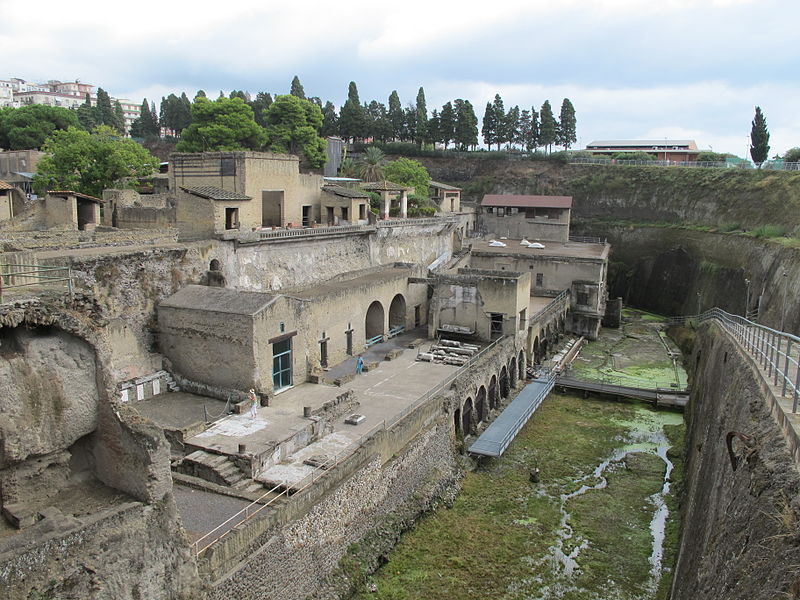
Herculaneum (/hɜːrkjʊˈleɪniəm/; Italian: Ercolano) was an ancient town, located in the modern-day comune of Ercolano, Campania, Italy. Herculaneum was buried under volcanic ash and pumice in the eruption of Mount Vesuvius in AD 79.
Like the nearby city of Pompeii, Herculaneum is famous as one of the few ancient cities to be preserved more or less intact as the ash that blanketed the town also protected it against looting and the elements. Although less well known today than Pompeii, it was the first, and for a long time the only, buried Vesuvian city to be found (in 1709), while Pompeii was only revealed from 1748 and identified in 1763.Unlike Pompeii, the mainly pyroclastic material that covered Herculaneum carbonized and preserved more wood in objects such as roofs, beds, and doors, as well as other organic-based materials such as food and papyrus.
Herculaneum is a city that there is now quite a bit of information on. However, for a while the city was eclipsed by the more well-known city of Pompeii. Although the cities are located a mere 13 km apart, Pompeii is often more popular in education systems than Herculaneum is. Herculaneum was discovered in 1709, whereas Pompeii wasn’t discovered until 39 years later in 1748. When Pompeii was discovered, a Russian named Karl Bryullov created an oil painting titled The Last Day of Pompeii which later inspired Edward Bulwer-Lytton to write his book The Last Days of Pompeii in 1834; both of which helped boost Pompeii’s popularity. Pompeii’s discovery caused excavations in Herculaneum to stop until the 1920s. This was due to the depth at which both cities were buried. While Herculaneum was buried underneath 20 meters of thick pyroclastic material, Pompeii was only covered with 4 meters of thinner ash, making it a significantly easier site to excavate.
3.Cinque Terre
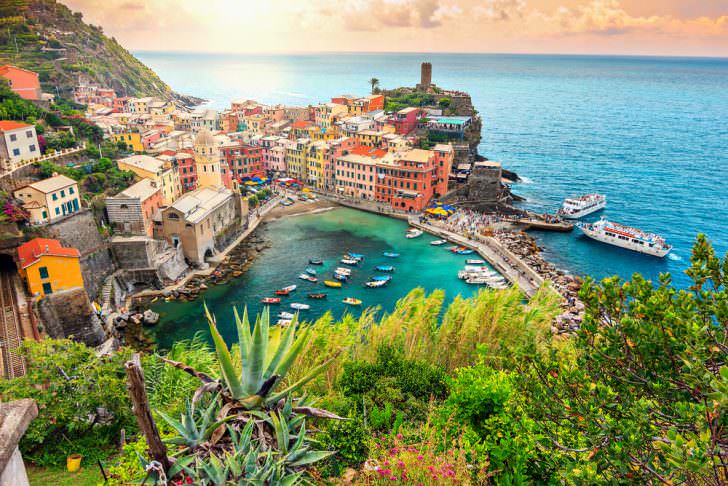
The Cinque Terre area is a popular tourist destination. Over the centuries, people have built terraces on the rugged, steep landscape right up to the cliffs that overlook the Ligurian Sea. Paths, trains, and boats connect the villages as cars can only reach them with great difficulty from the outside via narrow and precarious mountain roads.
Cinque Terre is mentioned in documents dating to the 11th century. Monterosso and Vernazza were settled first and the other villages grew later, whilst within the territory of the Republic of Genoa. In the 16th century, the inhabitants reinforced existing forts and built new defence towers to defend the area from attacks by the Turks
Access to Cinque Terre by car is limited. A road to Vernazza is very narrow and ends 1 kilometre (0.62 mi) before the town. Alternatively, drive to Bonassola, park your auto there, and take the local train two stops to Monterosso in the Cinque Terre. Trains run from La Spezia to all five towns within Cinque Terre, as well as to major regional and national destinations. The Cinque Terre railway stations are located on the Genoa-Pisa line. Most long-distance trains do not stop at all five Cinque Terre towns, making it necessary to transfer from La Spezia onto regional trains. Some intercity trains also stop at Monterosso Station.A scheduled passenger ferry runs between Levanto and La Spezia, stopping at all of the main villages except Corniglia, which does not have a landing point, as it is not located on the coast. Boats also connect to Genoa’s Old Harbour, Lerici, and Porto Venere.
Many walking trails run throughout the park and are named according to the SVA numbering system, however, it is common to hear trails referred to by their previous numbers, causing confusion to visitors.The most popular path is known as the Sentiero Azzurro (“Azure Trail”), used to connect the five villages.
Given its location on the Mediterranean, seafood is plentiful in the local cuisine. Anchovies of Monterosso are a local speciality designated with a Protected Designation of Origin status from the European Union.
4.Amalfi
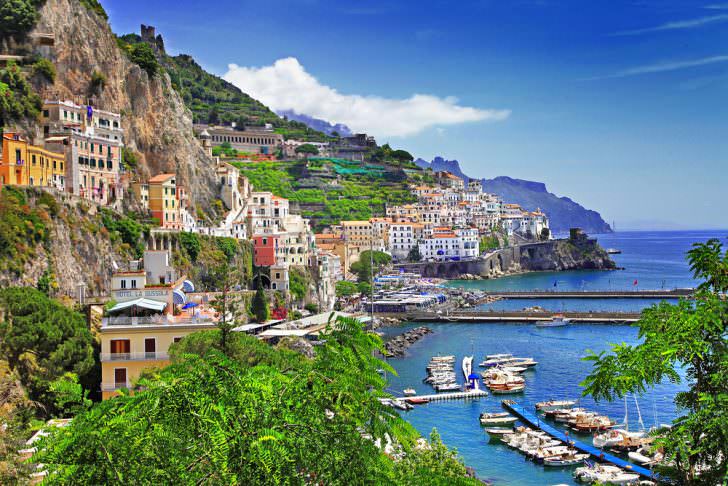
The town of Amalfi was the capital of the maritime republic known as the Duchy of Amalfi, an important trading power in the Mediterranean between 839 and around 1200.In the 1920s and 1930s, Amalfi was a popular holiday destination for the British upper class and aristocracy.
Amalfi is a town in a dramatic natural setting below steep cliffs on Italy’s southwest coast. Between the 9th and 11th centuries, it was the seat of a powerful maritime republic. The Arab-Norman Sant’Andrea cathedral at the heart of town, with its striped Byzantine facade, survives from this era. The Museo Arsenale Amalfi is a medieval shipyard-turned-exhibition space
Amalfi is the main town of the coast on which it is located, named Costiera Amalfitana (Amalfi Coast), and is today an important tourist destination together with other towns on the same coast, such as Positano, Ravello and others. Amalfi is included in the UNESCO World Heritage Sites.
5. Tower of Pisa
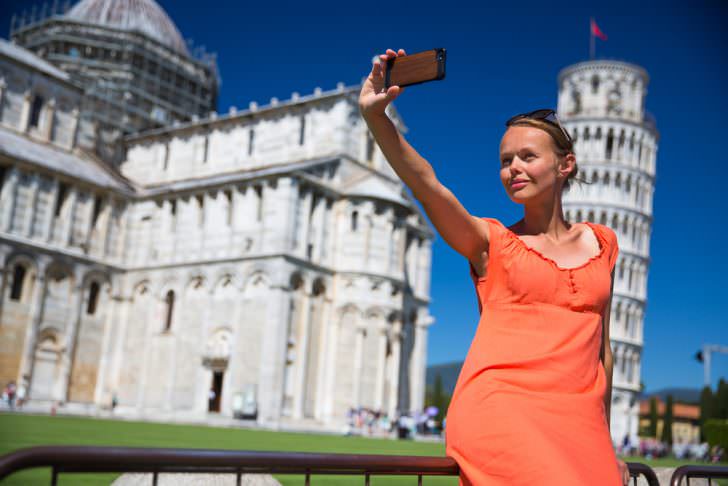
Construction of the tower occurred in three stages over 199 years. On 5 January 1172, Donna Berta di Bernardo, a widow and resident of the house of dell’Opera di Santa Maria, bequeathed sixty soldi to the Opera Campanilis petrarum Sancte Marie. The sum was then used toward the purchase of a few stones which still form the base of the bell tower. On 9 August 1173, the foundations of the tower were laid. Work on the ground floor of the white marble campanile began on 14 August of the same year during a period of military success and prosperity. This ground floor is a blind arcade articulated by engaged columns with classical Corinthian capitals. Nearly four centuries later Giorgio Vasari wrote: “Guglielmo, according to what is being said, in the year 1174, together with sculptor Bonanno, laid the foundations of the bell tower of the cathedral in Pisa”.
The Leaning Tower of Pisa (Italian: torre pendente di Pisa), or simply the Tower of Pisa , is the campanile, or freestanding bell tower, of the cathedral of the Italian city of Pisa, known worldwide for its nearly four-degree lean, the result of an unstable foundation.
6.Capri
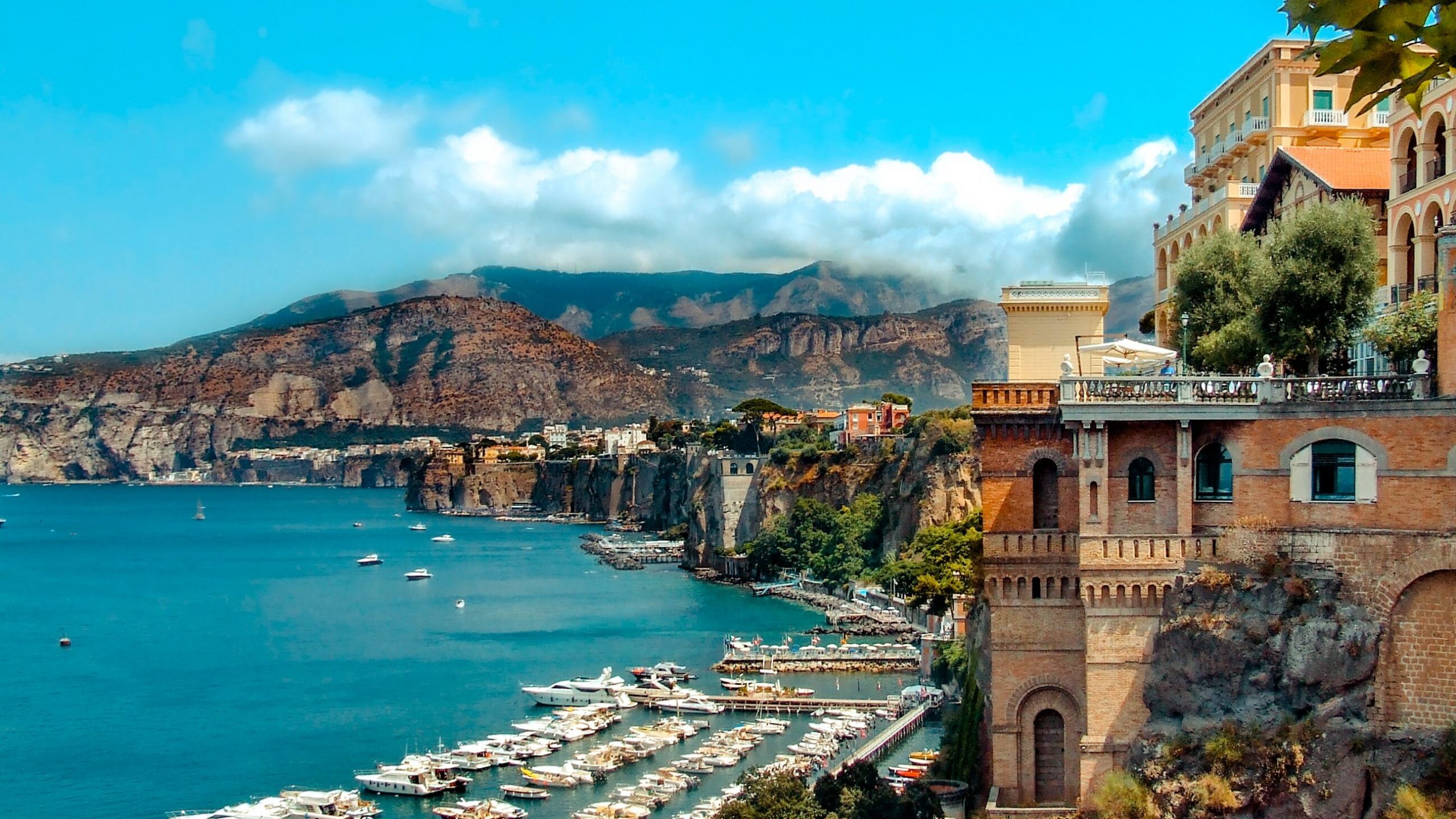
Island with resorts, shops & restaurants, offering mountaintop scenery & the famous Blue Grotto.
Capri, an island in Italy’s Bay of Naples, is famed for its rugged landscape, upscale hotels and shopping, from designer fashions to limoncello and handmade leather sandals. One of its best-known natural sites is the Blue Grotto, a dark cavern where the sea glows electric blue, the result of sunlight passing through an underwater cave. In summer, Capri’s dramatic, cove-studded coastline draws many yachts.
The most famous dish on Capri is ravioli capresi, made with a simple pasta dough using equal parts flour and water, resulting in a particularly light pasta. The filling is made with parmigiano and aged caciotta cheese, and marjoram, and the cooked ravioli are tossed with a fresh tomato and basil sauce.
7.Lake Garda
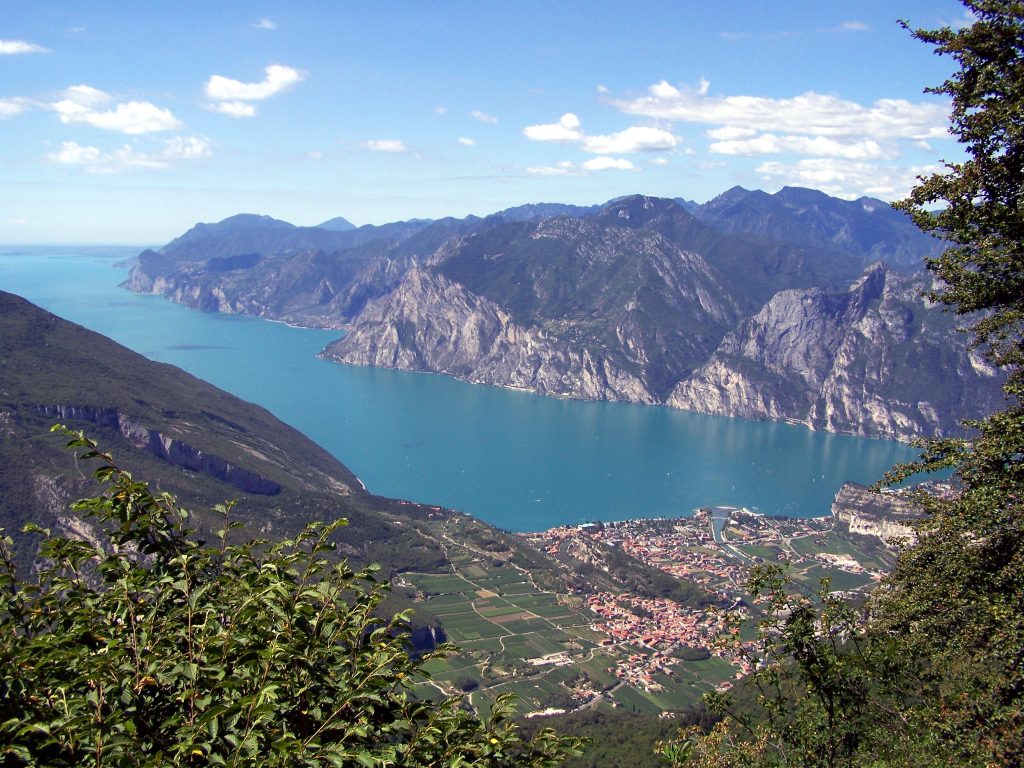
The largest lake in Italy, lined with towns & offering activities like boat rides, swimming & walks.
Lake Garda, in northern Italy, is known for its crystal clear water. At the south end, the town of Sirmione is dominated by the Rocca Scaligera, a fortress with harbor views. The nearby Grotte di Catullo archaeological site includes a Roman villa. On the lake’s western shore, in Gardone Riviera, is Il Vittoriale degli Italiani, former home of poet d’Annunzio. The Dolomites frame Riva del Garda, a resort in the north.
The water temperature in Lake Garda is around 20 °C (68 °F) from June to August, so it remains cool to swim in, even though it depends on the area (the southern part is a bit warmer than the northern one) and especially on the period: during the hottest summers.









